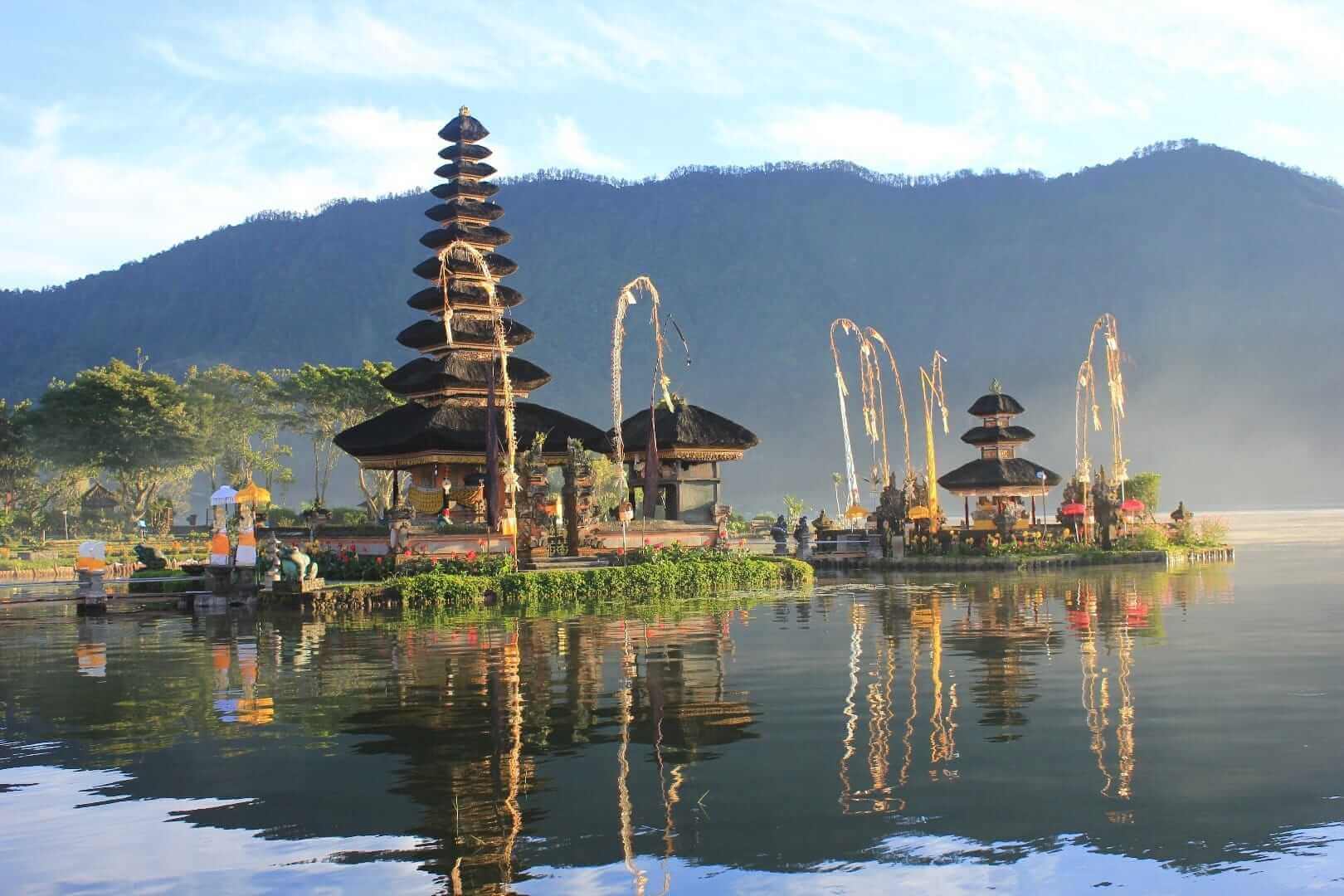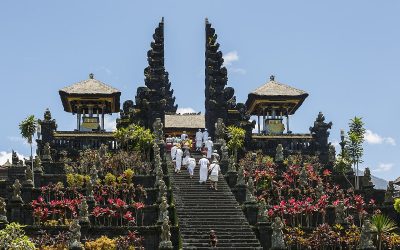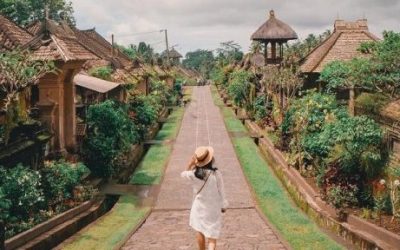Home / Batik Regions – Central Indonesia – Bali / Bedugul – Ulun Danu Beratan Temple
Cultural Destination
Embrace the spirit of the place!
Ulun Danu Beratan Temple in Bedugul
Bedugul, the site of the Ulun Danu Beratan water temple, is an excellent place for having a peaceful retreat or spiritual soul discovery. From its location on the high plateau right in the centre of the island, it commands a great view of the subak irrigation of Bali. You can walk around the lakes, surrounding hills, and visit the water temple to join the water purifying rituals. It is a magic place with cool air, mists, and the fragrance of flowers.
Tourist Attractions in Bali
Besakih Temple
Besakih Temple is regarded as Bali’s ‘Mother temple’ – a grand
Penglipuran Village
Penglipuran Village is awarded as the 3rd most beautiful and cleanest village in the world
Tanah Lot
Tanah Lot Temple is one of Bali’s most important landmarks, where
Bali
Batik Motifs
Buketan Bali
The Balinese bouquet (Buketan Bali) is a floral arrangement and the name is
Merak Abyorhokokai
The peacock batik motif depicts the bird’s beauty as the focal point of
Discover
Indonesian
Batik
Motifs
Sero Tangga
The Sero Tangga illustrates an endearing feeling and sacrifices of a person to fulfil
Awan Berarak
Awan Berarak is a combination of Dayak motifs and Malay patterns. The word ‘Awan Berarak’ means the
Sekomandi
Its philosophical meaning is the eternal union which refers to a saying “until death do us part”
Sido Mulyo
Sidomulyo is one of the classical motifs, which is specifically used for the bride’s costume in
Prada Papua
The word “Prada” in the Javanese-Indonesian dialect means a batik textile that
Buketan Bali
The Balinese bouquet (Buketan Bali) is a floral arrangement and the name is
Tanah Liek
The word “Tanah Liek” refers to clay in Minang language. It is also known as
Tenun Bima
The motifs are adopted from Bima woven textile. This pattern has received a great
Karawo Mahkuta
Mahkuta refers to Gorontalo’s traditional crown. It represents noble characters of
Gumin Tambun
Based on Hindu mythology, this motif symbolizes lucks, abundant wealth, and
Durian Pecah
Broken Durian motifs depict the foundation of faith. The second half signifies the mastery of
Daun Lada Hitam
The black pepper motif represents the main commodity of Bangka Belitung
Gajah Way Kambas
The motif illustrates the Lampung’s natural reserve, the Way Kambas. it also symbolizes
Parang Seling
Parang Seling or “alternating daggers” is a royal batik motif. It is a feminine variant of
Kuda Kupang
Horses symbolize wealth. It contains noble values of virtuous characters that bring
Kain Cual
Cual textile tradition has existed since the 17th century. The word “Cual” refers to
Manguni Minahasa
Manguni is identified as the symbol of the Minahasa people. Manguni is known as a
Taiganja
Taiganja is a precious gold pendant that shows the social status of the Kaili family. It is
Angsa Duo
According to legend, the Angso duo batik motif is a pair of swans that are believed to have led Princess
Gedhog Kembang Waluh
a combination of Javanese cultural motif of the Majapahit kingdom (XII-XIV century) with
Ikan tambal
The word “Ikan” refers to fish. The philosophical meaning of Ikan Tambal means is
Lok Baintan Floating Market
As you can imagine, the most authentic thing is that you can buy things and even
Tabir Tanjung
Tanjung flower is a type of Cherry tree flower, which is commonly found in
Rangkiang
The word “Rangkiang” refers to the rice granary in the Minangkabau language. It symbolizes
Gonggong Beruntun
This motif illustrates that a person should maintain a positive attitude and
Insang Ikan
Insang refers to the gills of the fish. This is a typical pattern of Malay ethnic who inhabits
Desa Na Tolu
The Desa Na Tolu characteristic pattern symbolizes the Batak philosophy of existence and
Malinau Cultural Festival
You will witness a unique competition that might not be found other than in
Kaganga Tanah Rejang
If Batik Besurek combines Arabic calligraphy motifs, then the Kaganga batik takes
Leuit Sijimat
This motif reflects the daily activities of the Baduy tribe in Banten. The main ornaments of batik motif consist of:
Gorga Simeol-Meol
The Gorga Simeol-meol is a pattern of plant tendrils. it is regarded as a symbol of longevity and
La Galigo
La Galigo is a literary work of the Buginese Epic that has 300 thousand epic lines. It is considered even
Bale Lumbu
This motif signifies the welfare of the ancient Sasak society. Bale also symbolizes the
Teguh Bersatu
This batik motif shows the strength of the people of Kupang. It also represents a sense of
Rumah Mamuju
the Batik motif illustrates the house of Mamuju King with the stairs, located on the left of the wooden stage house
Gigi Haruan Lidi
The Gigi Haruan Lidi motif is taken from the name of the cork fish and is a symbol of
Kawung
The Kawung motif was created by Sultan Agung Hanyokrokusumo (1593 – 1645) as a symbolic gift for
Bintik Tujuh
The Bintik Tujuh (Seven Dots) motif has 7 white spots and green color gradation as
Honai
The Honai is inspired by the traditional house of the Papuan community living in
Dayak Taghol
Dayak Taghol has a distinctive style of four curved lines and small dots. This motif represents
Gonggong Siput
Gonggong (Strombus Turturella) is one type of sea snail found around
Paqbarre Allo
The word “Barre” means round and “Allo” means the sunlight. This motif is interpreted as
Gurdo Solo
Gurdo or garuda bird is the mount of the Indian god Vishnu. As the Sun Bird,
Bomba Mawar
This motif means sacred love for family, kingdom, and God; It also illustrates
Hiu Taliyasan
Indonesia is also home to the world’s largest fish, the whale shark (Rhincodon typus). Hiu Taliyasan refers to
Sekar Jati
Sekar means flower and Jati refers to teak trees that symbolizes a strong mental character that
Tampuk Manggis Sasirangan
The motif illustrates the philosophy of the mangosteen fruit, which is
Tikar Natuna
The Tikar Natuna motif is adapted from the traditional making of pandanus mats in
Tifa Totobuang
The batik motifs illustrate Maluku’s traditional music instrument called
Wirasat
Wirasat or divine inspiration is a gift from God. This inspiration is symbolized by
Gamolan
This motif illustrates Gamolan, a bamboo musical instrument of Lampung that is
Srimanganti
The name of the Srimanganti motif is derived from Palace’s hallway that connects to
Parang Rusak
Another meaning behind this motif is an unconquerable spirit, symbolized by
Kaharingan
The Kaharingan or ‘tree of life’ based on the Dayak tribes’ belief system. This tree symbolizes
Ake Patra
Ake is related to the divinity and the composition of the universe. It is a symbol of
Besurek Rembulan
This batik illustrates praise for God who created the wonderful universe
Biji Kopi
The coffee seeds motif illustrates the pride of local coffee specialities in
Raja Ampat
Raja Ampat motif represents the marine life at Raja Ampat archipelago in
Tangerang Herang
Tangerang Herang motif is a symbol of Tangerang city. The Tangerang Herang batik motif consists of
Pohon Hayat (Tree of Life)
The Batik motifs in Lampung are dominated by the acculturation of Buddhist and
Singayaksa
The Singayaksa motif comes from the name of a place where Sultan Hasanuddin used to
Lipaq Sabe
Lipaq Saqbe contains a simple geometric classical motif with various flower decorations. This textile is
Pala Salawaku
This motif illustrates the unique weapons of the Maluku region, namely
Ukir Sentani
The Ukir motif is a batik motif that is inspired by various traditional Sentani wood carvings
Jupri Kembang Teh
Kembang Teh illustrates the tendrils of tea plants that grow in the highlands of
Enggang Dayak
Local people beliefs that hornbills are an incarnation of the Commander of the Birds. It has supernatural
Mahkota Siger
Siger is the crown of a noblewoman in ancient time. It is a symbol of femininity, strength, and
Karawo Pinang
Pinang refers to the Palm areca tree. This motif is considered as the original
Bekantan Pakis
This motif represents Pakis Haji (Polystichum setiferum), an endemic plant in
Gentala Arasy
Built as high as 80 meters, the tower also highlights the historical side of
Bultiya
The word ‘Bultiya’ is an acronym of the three major tribes in North Kalimantan, namely
Kerawang Tegak Aceh
The Vertical Upright (Kerawang Tegak) Motif symbolizes a person who has a strong
Sandeq
Sandeq Boat is a symbol of the maritime importance of the West Sulawesi region. The greatness of




